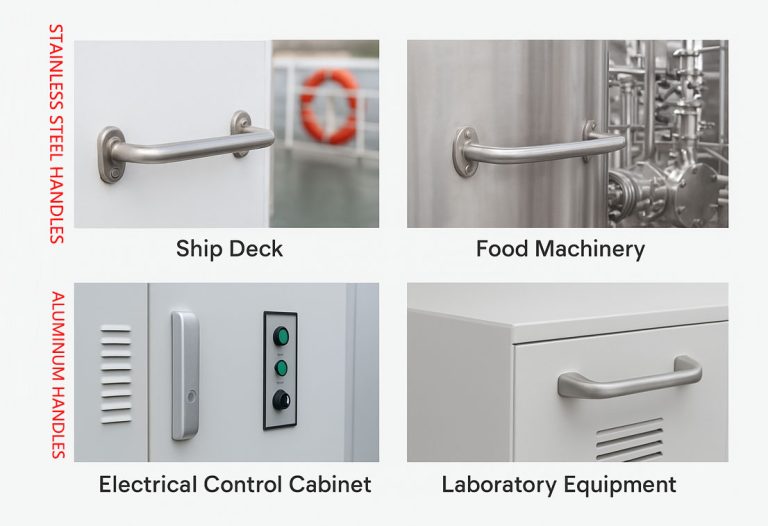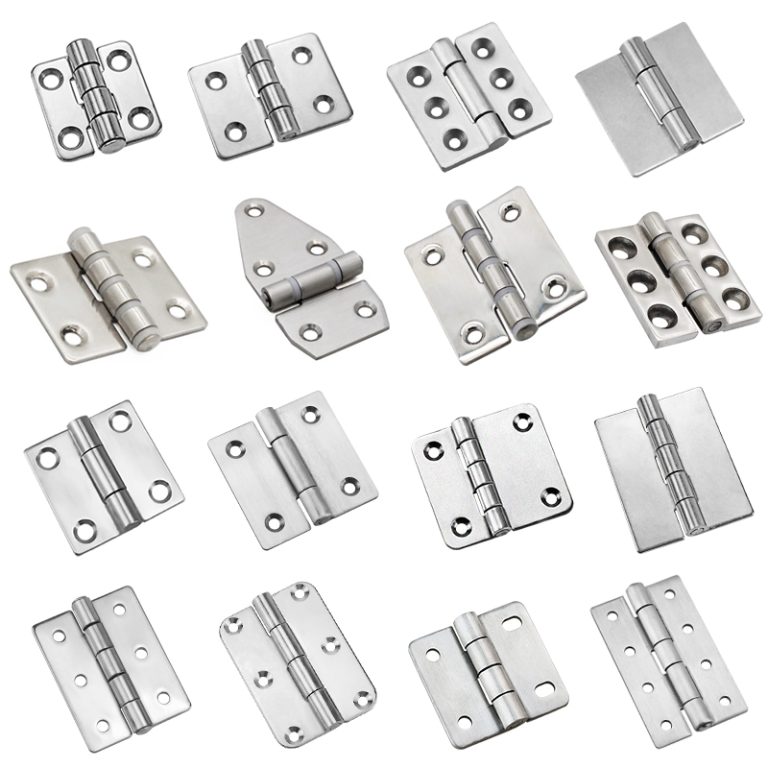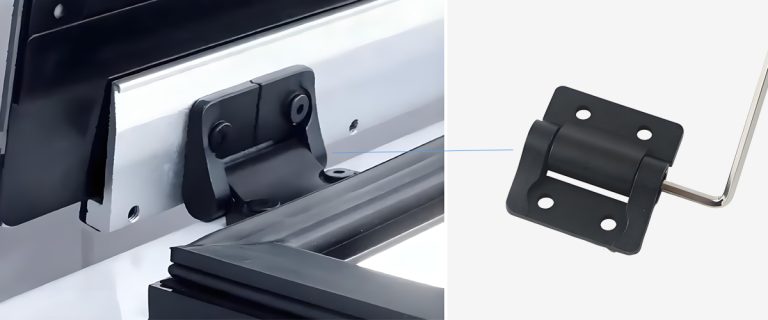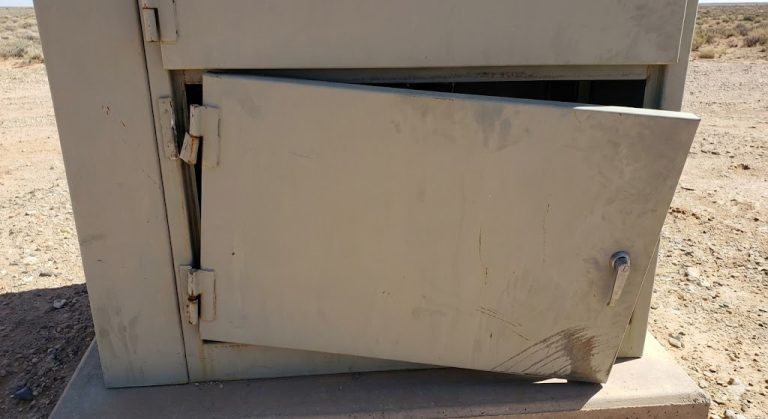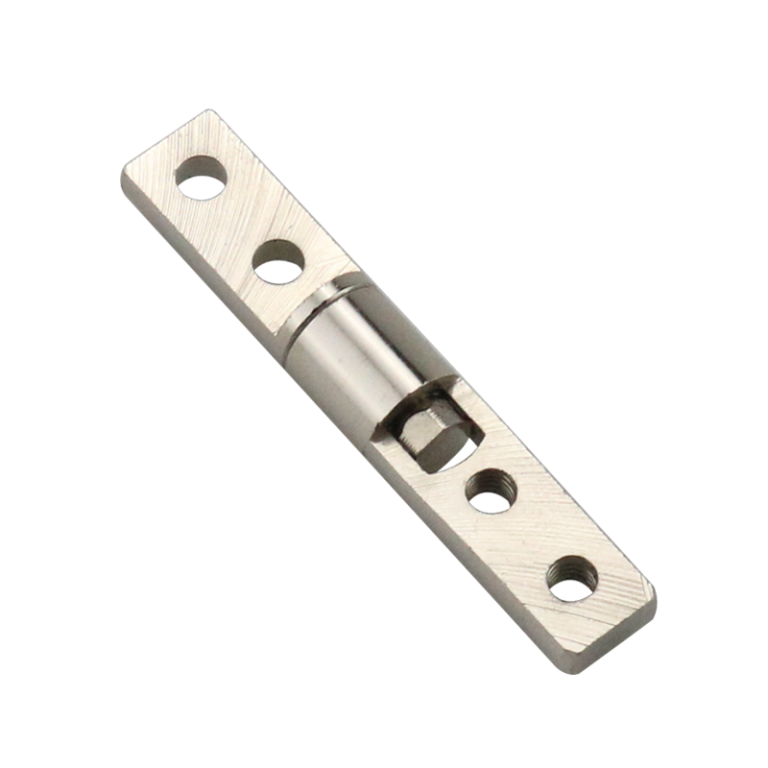HTAN es uno de los principales fabricantes de bisagras, manillas y pestillos industriales de China.
Los diseñadores libran una batalla constante, especialmente en el diseño de portátiles ultrafinos o pantallas plegables donde cada milímetro cuenta. El espacio interior es cada vez más escaso. Las modernas demandas de miniaturización, integración y diseño ligero de los productos comprimen aún más el espacio disponible para los componentes estructurales.
Las soluciones tradicionales, como las bisagras combinadas con muelles de gas o sistemas multibrazo, suelen resultar contraproducentes. Incluyen numerosas piezas, son voluminosas y complican la instalación y el calibrado. Estos conjuntos de varios componentes no sólo ocupan un espacio valioso, sino que ralentizan la producción, aumentan los costes de mano de obra y elevan el riesgo de fallos.
Este es el doble reto del "espacio" y el "montaje". Bisagras de torsión compactas ofrecen una respuesta directa. Ofrecen un soporte de apertura y cierre suave y pueden mantener una posición en cualquier ángulo en un espacio extremadamente reducido. Esto las convierte en una innovación clave del diseño moderno.
El doble reto del espacio y el montaje: Dónde encajan las bisagras de torsión compactas
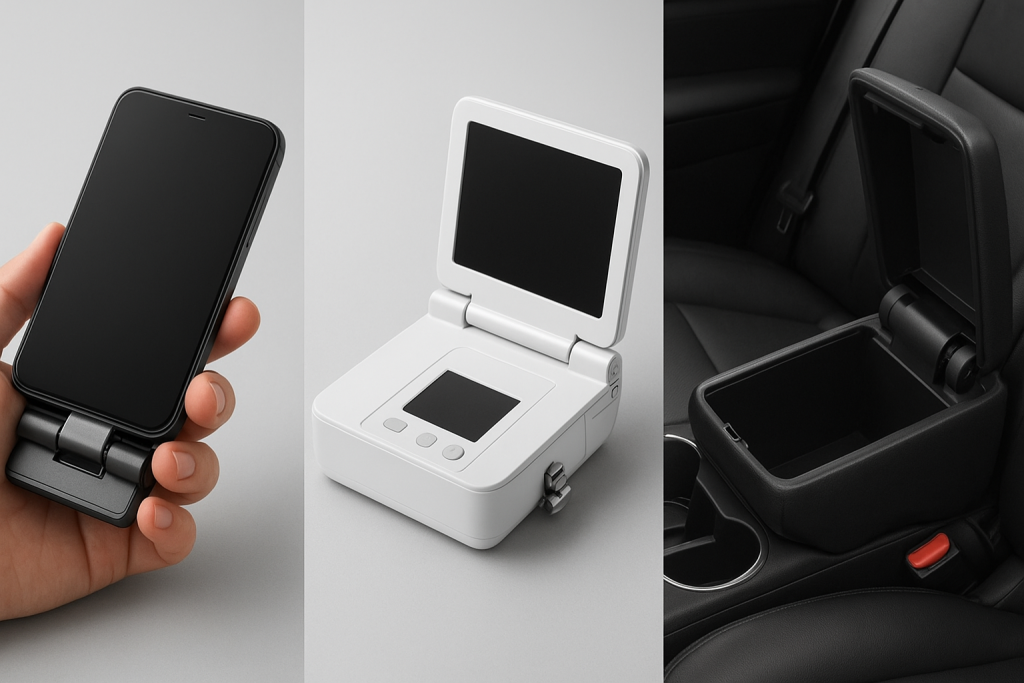
Fotos de productos típicos de electrónica de consumo, dispositivos médicos e interiores de automóviles
Electrónica de consumo: La necesidad de miniaturización en un espacio limitado
Las limitaciones de espacio son un reto primordial en la electrónica de consumo. Smartphones, tabletas y gafas de realidad aumentada buscan cuerpos más delgados y ligeros. Los componentes internos están muy integrados, lo que deja poco espacio para las piezas mecánicas. Innovaciones como las microbisagras hacen posibles diseños compactos.
Dispositivos médicos: Equilibrar la integración de funciones con bisagras compactas
La industria de dispositivos médicos se enfrenta a presiones similares. Los monitores portátiles, las lámparas quirúrgicas y los equipos de diagnóstico deben integrar múltiples funciones en un volumen limitado. Los componentes mecánicos, como las bisagras, deben ser extremadamente precisos y compactos. El espacio desaprovechado puede obligar a agrandar las carcasas de los dispositivos o limitar su funcionalidad.
Interiores de automóviles: Combinar estética y eficiencia espacial
El interior de los automóviles también requiere una gestión inteligente del espacio. Cada vez son más comunes las pantallas abatibles en la consola central, los compartimentos ocultos y los sistemas de entretenimiento en los asientos traseros. Las bisagras para estas aplicaciones deben proporcionar un movimiento suave y silencioso sin ocupar demasiado espacio. Por ejemplo, la bisagra de una pantalla central retráctil debe quedar completamente oculta dentro del salpicadero, sin comprometer la estética ni el espacio de almacenamiento.
Deficiencias del ensamblaje tradicional frente a las bisagras de torsión
| Característica | Bisagra libre tradicional | Bisagra de torsión compacta |
|---|---|---|
| Función | Oscilación libre, no puede mantener la posición | Mantiene la posición en cualquier ángulo |
| Estructura | Estructura mecánica sencilla | Muelles/discos de fricción incorporados |
| Talla | Más grande, requiere apoyo adicional | Compacto, ideal para estructuras finas |
| Aplicaciones | Puertas de armarios, tapas básicas | Pantallas de gama alta, paneles de precisión |
Los métodos de montaje tradicionales presentan claros inconvenientes: numerosas piezas y procesos complejos. Los sistemas de resorte de gas suelen requerir bisagras, correderas y varillas de resorte, además de laboriosos ajustes del equilibrio de fuerzas durante la instalación.
Por el contrario, las bisagras de torsión integradas eliminan estos componentes adicionales, simplificando fundamentalmente el montaje. Un montaje complejo conlleva mayores costes de mano de obra, velocidades de producción más lentas y más errores potenciales, problemas que las empresas necesitan resolver urgentemente. El mercado demanda soluciones innovadoras que se adapten a espacios reducidos y simplifiquen el montaje. Las bisagras de torsión compactas son precisamente esa solución.
Cómo funcionan las bisagras de torsión compactas: Un análisis de los principios y la estructura interna
Fricción y amortiguación: El mecanismo central en un paquete pequeño
Una bisagra de torsión compacta es un componente de precisión. Proporciona una fuerza de amortiguación rotacional constante o ajustable dentro de un volumen mínimo. Un mecanismo de fricción interno permite que una pantalla o panel permanezca inmóvil en cualquier posición sin autocierre.
El principio básico es el siguiente: El cilindro de la bisagra contiene elementos amortiguadores, que pueden ser muelles, discos de fricción o fluido viscoso. Cuando la bisagra gira, estos elementos generan una fricción controlada que contrarresta el peso del componente conectado (como una tapa). En pocas palabras, la bisagra crea resistencia durante el movimiento; cuando el usuario deja de aplicar fuerza, el componente permanece en su sitio.
"Compacto y con par: Diseño estilizado y estabilidad para todos
"Compacto" es una ventaja fundamental. En comparación con las bisagras tradicionales con sistemas de soporte, las bisagras de torsión son mucho más pequeñas y pueden incrustarse en chasis ultrafinos, lo que libera espacio para baterías o componentes electrónicos y permite diseñar productos más elegantes.
El "par" es igualmente crítico. Determina el peso que puede soportar la bisagra e influye en la suavidad de la sensación de apertura y cierre. Las bisagras de torsión de alta calidad mantienen un rendimiento estable a lo largo de 20.000-30.000 ciclos de apertura/cierrecon un decaimiento del par típico <15%. El potente par motor garantiza un funcionamiento suave de los paneles pesados, mientras que la fina amortiguación mejora la experiencia del usuario.
Comparación de prestaciones: Bisagras de torsión compactas frente a bisagras tradicionales
Ventajas diferenciales en estructura y función
La tabla anterior destaca las principales diferencias. Las bisagras tradicionales requieren dispositivos adicionales para mantenerse abiertas, mientras que las bisagras de torsión compactas llevan amortiguación incorporada, pueden mantener posiciones de forma independiente y son adecuadas para aplicaciones con grandes exigencias de espacio y posicionamiento.
Sujeción de la posición en cualquier ángulo: Un factor clave para mejorar la experiencia del usuario
"La sujeción en cualquier ángulo" no es sólo una ventaja técnica, sino una mejora directa de la seguridad y la satisfacción del usuario. Por ejemplo, un monitor portátil que se mantiene fijo en el ángulo elegido mejora notablemente la comodidad y la facilidad de uso.
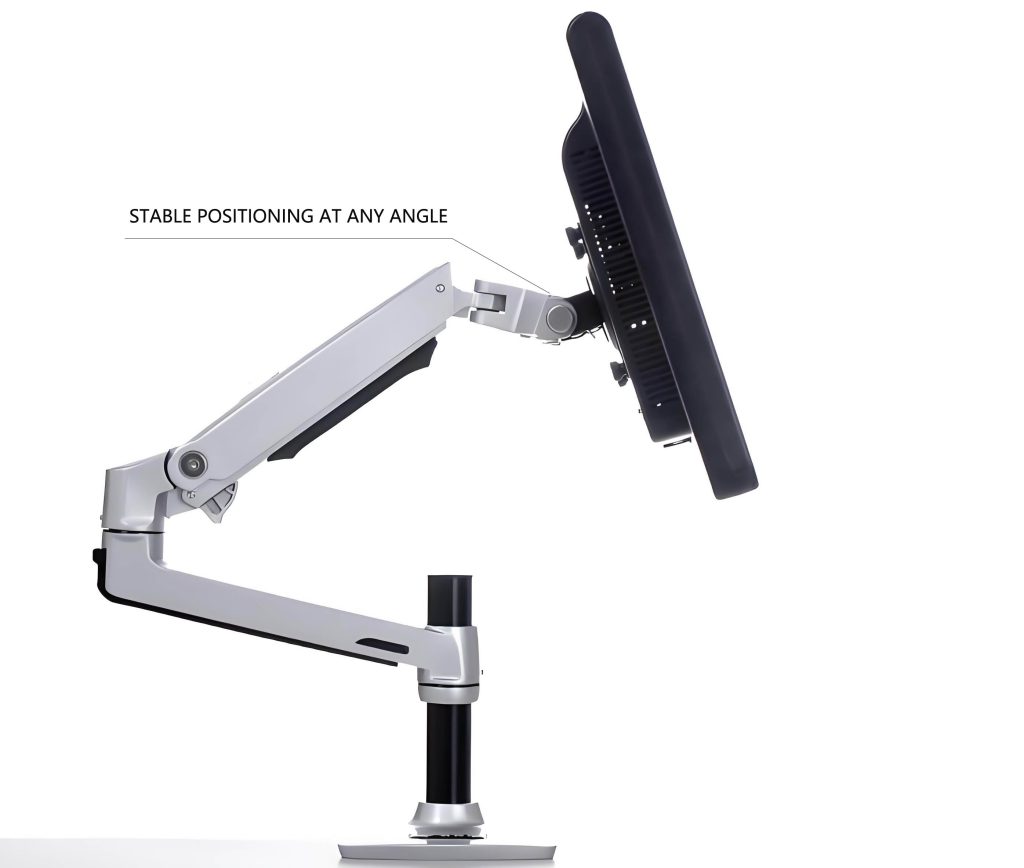
Equipado con una bisagra de torsión, este soporte para monitor garantiza un posicionamiento estable en cualquier ángulo
Las cuatro ventajas principales de las bisagras de torsión compactas
Aprovechamiento máximo del espacio interior
- Integrado en biseles estrechos y chasis ultrafino
- Ahorra espacio para baterías más grandes o módulos añadidos
- Permite diseños más delgados en portátiles, plegables y monitores portátiles
Simplificación del montaje y reducción de los costes de fabricación
- Sustituye a "bisagra + brazo soporte" → menos piezas.
- Reduce tiempo de montaje al eliminar el calibrado
- Recortes transporte, almacenamiento e índices de error con lista de materiales simplificada
Mejora de una experiencia de usuario fluida y estable
- Amortiguación constante para un movimiento suave y silencioso
- Sujeción de posición en cualquier ángulo evita los chasquidos repentinos
- Más seguro y cómodo para el mantenimiento y los ajustes
Mejora de la durabilidad y la fiabilidad a largo plazo
| Parámetro | Bisagra de torsión compacta (High-End) |
|---|---|
| Ciclo de vida | 20.000 - 30.000 ciclos de apertura y cierre |
| Decaimiento del par | < 15% tras las pruebas del ciclo de vida |
| Mantenimiento | No es necesario |
| Opciones de material | Acero inoxidable, aleaciones, plásticos |
Escenarios de aplicación: El valor multiindustrial de las bisagras de torsión compactas
| Industria | Ejemplos de aplicaciones | Requisitos de las bisagras |
|---|---|---|
| Electrónica de consumo | Portátiles, teléfonos plegables, monitores portátiles | Par ultrafino y estable |
| Productos sanitarios | Monitores de cabecera, luces quirúrgicas, cubiertas de ultrasonidos | Precisión, fiabilidad |
| Automoción | Pantallas retráctiles, tapas de la consola central, pantallas traseras | Movimiento oculto, suave y silencioso |
| Automatización industrial | Puertas del panel de control, cubiertas protectoras | Durabilidad, fácil montaje |
Cómo seleccionar la bisagra de torsión compacta adecuada
Calcular el par necesario en función del peso y el tamaño
T=L2×W×cos(θ)T = \frac{L}{2} \veces W veces cos(θ)
- T = par requerido (N-m)
- L = altura del panel/puerta (m)
- W = peso del panel (N)
- θ = ángulo de apertura
👉 Aplicar una factor de seguridad de 1,2-1,5 y confirmar con los datos del proveedor.
Evaluar las opciones de montaje en función de las limitaciones espaciales
Estilos comunes: montados en el eje, fijos en la base, a presión.
Recomendación: simular el espacio de instalación en CAD para evitar interferencias posteriores.
Seleccionar los materiales adecuados en función del entorno operativo
| Entorno operativo | Materiales recomendados |
|---|---|
| Húmedo / Corrosivo | Acero inoxidable (304/316), aleaciones especiales |
| Diseño ligero | Aluminio, plásticos técnicos |
| Temperatura alta / baja | Lubricantes verificados + aleaciones estables |
| Durabilidad superior | Híbrido: carcasa metálica + discos de plástico |
Verificar la vida útil y los datos de las pruebas para garantizar la fiabilidad
Solicitar informes de pruebas con recuento de ciclos + datos de decaimiento del par.
Para medicina y automoción se recomiendan encarecidamente las certificaciones.
Conclusiones: Las bisagras de torsión compactas son un componente clave para el diseño futuro
A medida que los diseños sigan tendiendo a ser más pequeños, ligeros e inteligentes, el conflicto entre espacio y montaje no hará sino intensificarse.
Las bisagras de torsión compactas, con su filosofía de ingeniería única y sus ventajas, se están convirtiendo en un componente esencial para mejorar la competitividad y la experiencia del usuario.
No son meros elementos de apoyo, sino que son clave para permitir nuevos diseños, nuevas experiencias y nuevo valor. Recomendamos a diseñadores e ingenieros que consideren activamente el uso de bisagras de torsión compactas en sus productos de próxima generación.
PREGUNTAS FRECUENTES
P1: ¿Cuál es la diferencia entre una bisagra de torsión y una bisagra de fricción?
Los conceptos se solapan. "Bisagra de torsión" es una categoría más amplia que incluye mecanismos como muelles, discos o fluidos amortiguadores. "Bisagra de fricción" suele referirse específicamente a diseños de resistencia disco/arandela.
P2: ¿Se puede ajustar el par de apriete de una bisagra dinamométrica compacta?
Sí. Las opciones incluyen par fijo (ajustado de fábrica) y par ajustable (ajuste fino mediante tornillos prisioneros). Elija en función de las necesidades del proyecto.
P3: ¿Qué materiales se suelen utilizar para estas bisagras?
| Tipo de material | Escenario adecuado |
|---|---|
| Acero inoxidable | Entornos húmedos o corrosivos |
| Aluminio | Dispositivos electrónicos ligeros |
| Aleaciones y plásticos | Durabilidad y amortiguación equilibradas |
P4: ¿Cuál es la vida útil típica de una bisagra de torsión compacta de alta calidad?
20.000-30.000 cicloscon decaimiento de par <15%. Verifique siempre con los datos de prueba del fabricante.
P5: ¿Dónde puedo encontrar bisagras de torsión compactas fiables?
| Marca / Proveedor | Características principales |
|---|---|
| Southco | Amplia gama de pares, electrónica industrial y de consumo |
| Sugatsune | Bisagras de precisión, calidad de ingeniería japonesa |
| LEECO | Rentabilidad y facilidad de uso |
| HTAN | Bisagras especiales, soluciones a medida |



